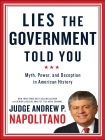Lies the government told you by Andrew Napolitano (best e reader for epub TXT) 📗

- Author: Andrew Napolitano
Book online «Lies the government told you by Andrew Napolitano (best e reader for epub TXT) 📗». Author Andrew Napolitano
There was a final hindrance to their plan, the upcoming presidential elections. The bill had been written and would quickly pass the House and Senate, but the final step was the need for a President who would not veto the bill. President William Howard Taft, who had previously stated that he did not support the bill and would veto it the first chance he got, was running for reelection. At the time, his reelection was almost certain, as the Republicans were the popular party and Taft was not facing any campaign problems. But the bankers, in order to pass their bill through, needed their Democratic candidate, Woodrow Wilson, to take the presidency. This was the same man who had stated during the 1907 Panic that “[a]ll this trouble could be averted if we appointed a committee of six or seven public-spirited men like J. P. Morgan to handle the affairs of the country.”12 Wilson could not be a more perfect candidate.
It was soon apparent that Wilson would not be able to garner enough votes to overcome Taft. It was at this point that ex-president Theodore Roosevelt, a Republican, entered the race as an independent. The bankers had found a way to divide Republican votes and therefore ensure the election of their Democratic candidate. Naturally, the majority of Teddy Roosevelt’s campaign was funded by close allies of J. P. Morgan himself. Wilson won the election, though with only 45 percent of the popular vote. In a two-man race, without the Republican split, Taft was likely to have won, and the Federal Reserve Act would have lost. Instead, less than a year after his election, Wilson signed the Federal Reserve Act into law.
The Non-Federal, Non-Reserve, Federal Reserve
When signing it into law, President Wilson claimed that the Federal Reserve Act would “supplant the dictatorship of the private banking institutions” and “stabilize the inflexibility of the national bank note supplies.” As advertised, the Federal Reserve was to be a politically independent private entity, yet it was also to be controlled by Congress. It was to ensure economic stability and prevent future crises. Originally, the Act was only given a life of twenty years, but that time ran out when FDR was president.
The Federal Reserve is composed of three parts. The first is the Board of Governors, which is responsible for determining monetary policy. Seven people are appointed by the President and confirmed by the Senate for a term of fourteen years, and they decide how much money they will print, what the interest rate will be, and essentially control every aspect of our monetary system.
Then there are the Regional Reserve Banks, which hold the cash reserves of the system, supply currency to member banks, and act as the fiscal agents of the government; each is run by a regional president and regional bank boards elected by member banks.
Finally, there is the Open Market Committee, which implements the monetary policy provided by the Board of Governors. It does this through the manipulation of the money supply via the purchase or sale of government securities. In essence, when the Fed buys government securities, money is made and interest rates fall; when it sells government securities, the money supply is reduced and interest rates rise. The committee is made up of the board as well as five of the regional directors. Bond dealers who earn large commissions on every transaction handle the purchases and sales of the securities.
The most common claim about the Federal Reserve is that it is accountable to the federal government because it is required to report to Congress twice a year regarding its activities. But what the chairman reports and what actually occurs are very different. Because the government has no power over the Federal Reserve, under current law the Federal Reserve cannot be audited. As well, its decisions do not require ratification by anyone in the executive or legislative branches of the government. Each time Congress has requested that the Federal Reserve submit to a voluntary audit, only refusals have been received. The Chairman of the Fed is therefore free to say anything he wants to Congress, and there is no way to verify the truth of his statements.
The monetary policy decisions made by the Fed are made at secret meetings, and Congress, as well as the public, are only made privy to brief reports released weeks later. Any transcripts made of the deliberations are destroyed. Every other government agency, even the CIA and NSA, are required by law to maintain all documents and transcripts of their activities.13 Since the Federal Reserve is not a government agency, these laws do not apply.
I have said this many times on air and elsewhere, and even the Fed’s supporters agree with me on this: The job of the CIA is to steal and to keep secrets; yet, we know far more about the CIA than we do about the Federal Reserve.
The Federal Reserve is a misnomer. As an initial matter, there is nothing “federal” about it. The government does not own a single share





Comments (0)